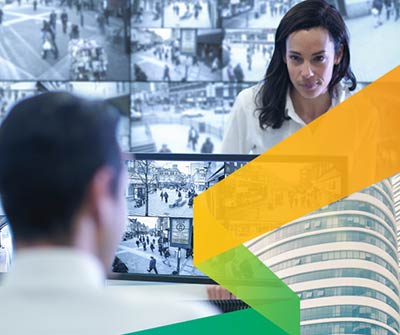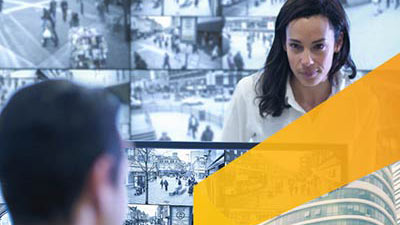Protecting Lives and Property
The right network infrastructure can help prevent or mitigate a disaster
In managing your building’s LAN network, you hope for the best but always plan for the worst—the worst being an emergency situation that puts lives and property at risk. If you can’t safeguard employees and visitors, nothing else matters, which is why your network infrastructure is so important.
Ideally, your physical layer cabling network should help protect lives and property before an emergency develops. If a crisis does occur, the cabling infrastructure can be a lifeline, enabling those who are trapped or endangered to call for help, allowing first responders to quickly locate victims, and helping to coordinate rescue efforts. From the structured cabling network to the multiple connected systems—like in-building wireless, building security and lighting—virtually every aspect of your building’s physical layer infrastructure plays a role in protecting lives and property.
Like what you've read so far...
Like what you've read so far...
Connecting when seconds count
During an emergency, the in-building wireless (in-building wireless) network is critical. In addition to carrying standard mobile traffic, these systems are increasingly deployed to support dedicated public safety frequencies used by emergency response personnel. These include terrestrial trunked radio (TETRA), VHF/UHF bands and, more recently, LTE bands such as FirstNet® in the U.S. Regulatory requirements regarding these systems vary by country and region, but in-building wireless support for local public safety bands is quickly becoming commonplace. In some cases, it is required in order to obtain occupancy or building permits—especially for large buildings.
In-building wireless solutions also provide critical cellular connectivity to employees or other building occupants who may find themselves unable to communicate or escape the building in an emergency. Since the outdoor cellular network has difficulty penetrating buildings, getting a reliable connection may well depend on the presence of an in-building wireless solution in the enterprise. This is particularly true in locations like elevators, basements or other interior spaces that are notoriously hard to reach from the outside network.
Reliable Wireless Becoming Essential
An estimated 80 percent of all mobile calls originate indoors; more importantly, a portion of those calls involve an immediate threat to personal health or public safety. A resilient in-building wireless network is a must-have.
Spotting trouble early
The internet of things (IoT), powered-fiber cabling and enhanced power over Ethernet (PoE) have allowed the expanded use of connected devices to improve monitoring and management of various building systems and spaces. Many of these systems play a key role during an emergency. Video surveillance equipment helps first responders find trapped occupants. Emergency lighting, which can be run as a low-voltage system, enable those in the building to safely exit. Networked sensors can detect and address hazards like fire before they get out of control. Keeping these systems operational even when the building’s main power supply is interrupted can save lives and property.
Materials matter
Most jurisdictions now enforce fire ratings for various building materials. The structured cabling that supports the enterprise network is no exception. The fire ratings for cable are intended to ensure the materials used in various IT and A/V cabling meet local fire safety requirements. Some ratings are based on the cable’s survivability in fire conditions, what temperatures it can endure, and what kind of chemicals are released when it burns. Other ratings indicate that the cable meets the minimum requirements for use in specific applications.
Implementation recommendations
In-building wireless support for public safety frequencies
Different regions specify different public safety frequencies, so the in-building wireless solutions supporting those frequencies must comply with the local “authority having jurisdiction” or AHJ. Other specific requirements will apply depending on the kind of structure in which the in-building wireless solution is operating. Some regions are migrating from TETRA frequencies to the 700- 800 MHz range of the LTE spectrum, but the migration will take years to complete—with progress across global markets varying, sometimes greatly.
Resilient cabling for security monitoring and sensor networks
Enhanced connectivity like that found in intelligent buildings allows for networks of IP security cameras and occupancy sensors that help spot intruders or help locate trapped personnel in the event of an emergency. With the right cabling infrastructure, these power-over-Ethernet (PoE) devices can be placed just about anywhere they’re needed for optimal coverage. More importantly, the low-voltage networks supporting these systems must remain operational should power to the building be interrupted or cut. Powered-fiber cabling as well as PoE networks offer the advantage of being powered at the switches, which are typically supported by UPS backup batteries. As a result, they can operate independent of the main power supply.
Standards-based cable design and construction
It is critical that all infrastructure cabling meet or exceed minimum fire safety ratings. These can vary significantly by location, so it is important to consult the local authority having jurisdiction. Enterprise network managers should be aware of the local regulations and applicable industry standards—making sure any cabling that is used meets or exceeds the requirements.
Partner with CommScope to realize the potential in your enterprise networks
In the always-connected world of enterprise IT, it is easy to measure wins and losses by throughput, productivity and cost efficiency. In the wake of an emergency, we are reminded what truly matters: people and families.
As a trusted partner with many of the world’s most respected companies, CommScope never loses sight of what’s important. While our innovations have helped define today’s connected and intelligent buildings, our most valuable contributions are those that place people above productivity. Just another way we help you create a smarter, safer workplace. You know what you need—we know what’s next. Together we can realize your full potential.

If you are interested in this topic, then you may also be interested in these resources:
Ask questions. Get answers in hours.





